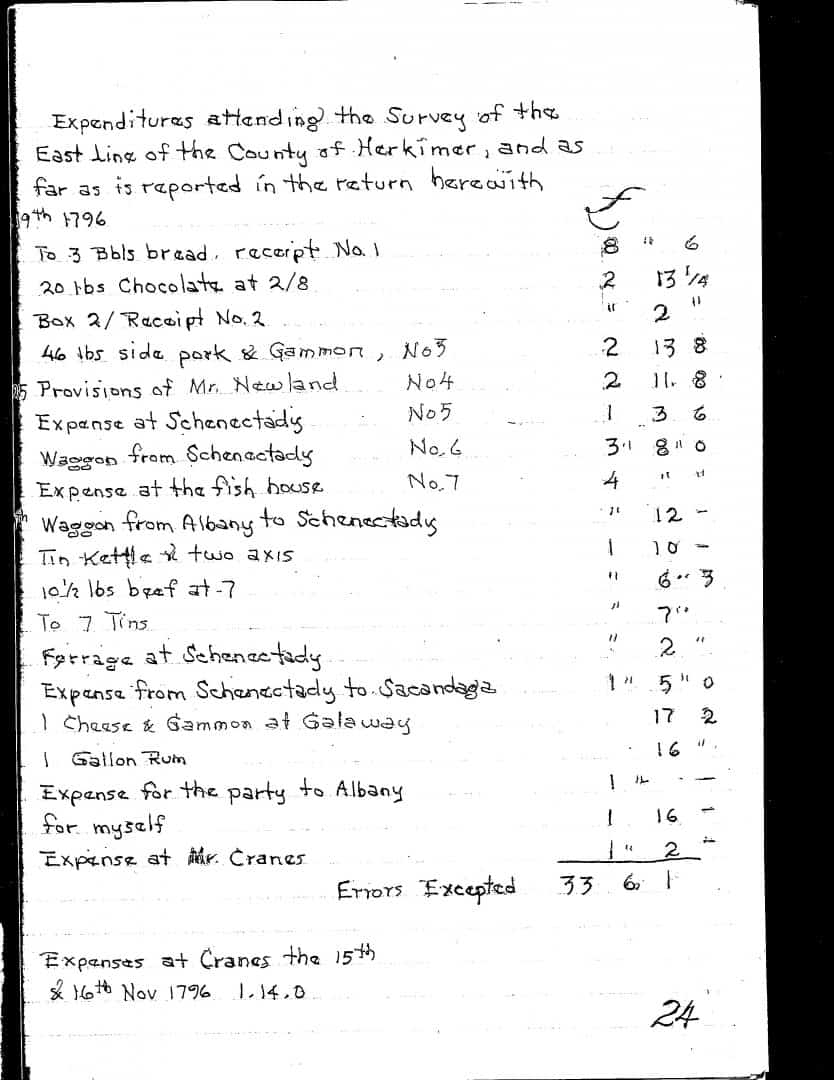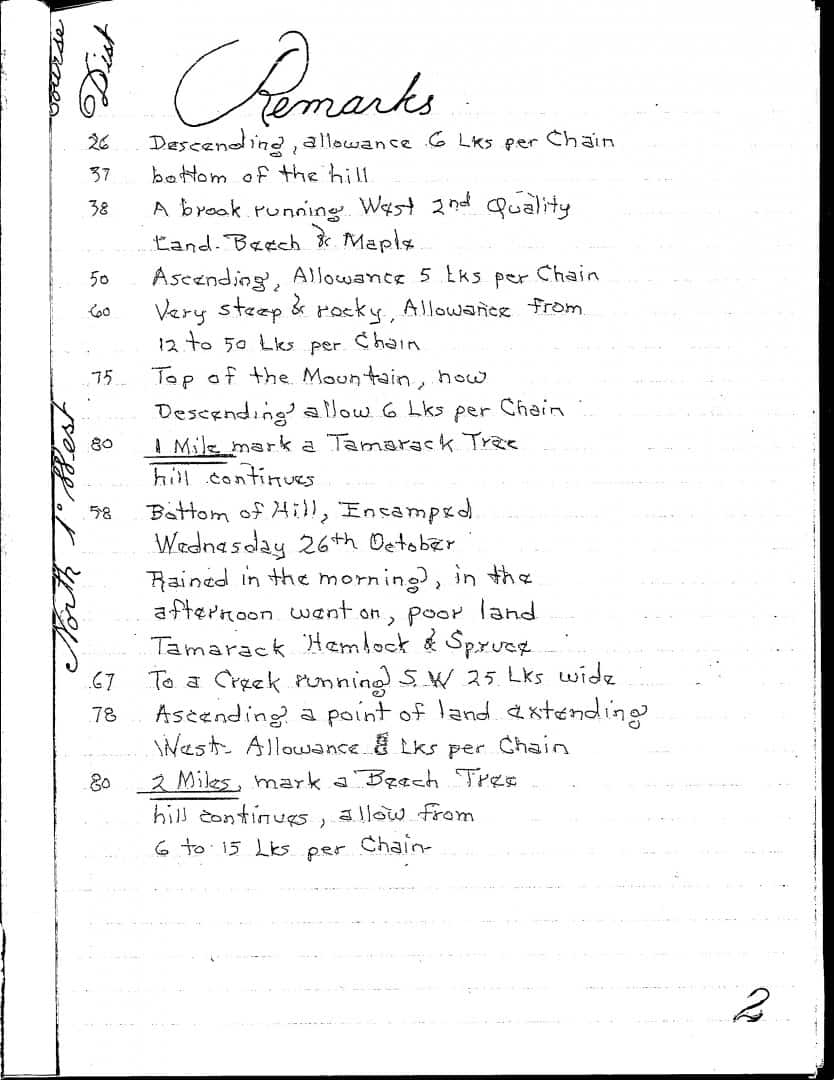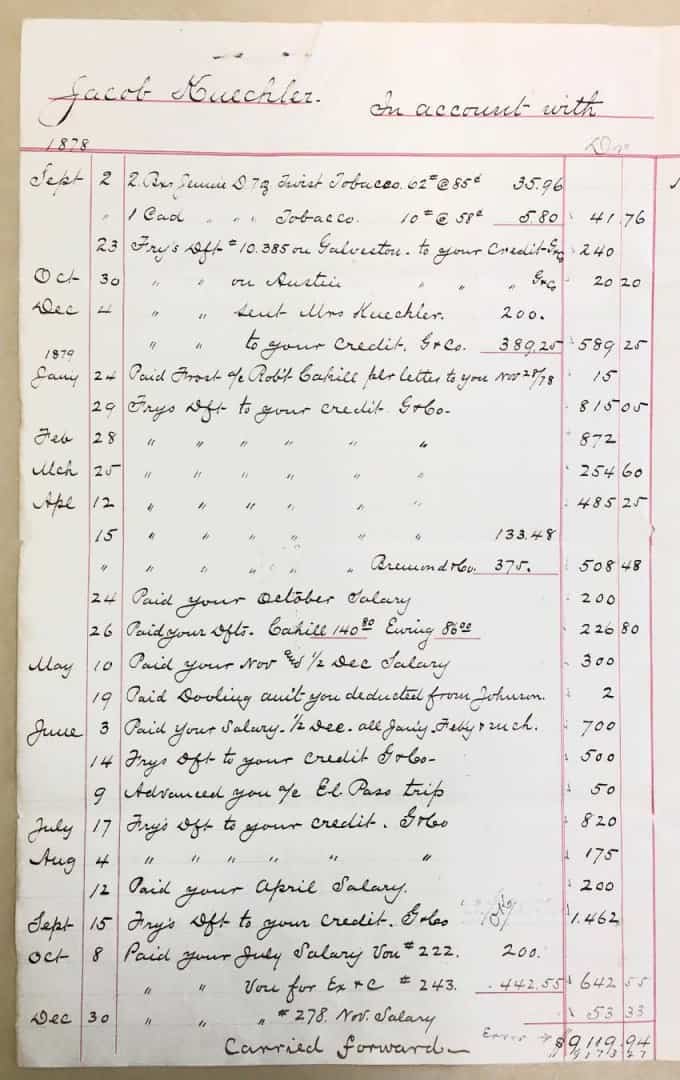On August 31, 1878, the Texas & Pacific Rwy. Co. contracted with former Texas GLO Commissioner Jacob Kuechler to organize a surveying party of up to ten men to make a survey within a strip of land lying between the Texas-New Mexico border and a parallel line drawn 80 miles South of there, extending West from the Pecos River to El Paso and the Rio Grande. In all the Texas & Pacific Rwy. Co. held land scrip entitling it to about 2600 sections of land with a like number of sections to be surveyed for the State of Texas under the terms of the act that the lands were granted. Okay, thats a total of over 5000 square miles to be surveyed with a party of ten men.
Put yourself in Kuechler's shoes. Sure, you'd want to hire some chain carriers, a cook, and some other outfitters along with some assistants you'd trust to run the compass and keep notes. Naturally, you'd hire your son, Carmelo Kuechler (if you had a son by that name), but then you'd get to the tricky part, namely: how much tobacco should you buy to bring along on the expedition that would mostly be well away from the stores where such commodities were sold?
This snippet of the account of Jacob Kuechler archived (along with some of his field books) at the Briscoe Center for American History at the University of Texas answers that last question:
I have in my possession a book that lists a record of cash expenses incurred by George Spiller on his and Capt. Mabry's survey of the Houston and Great Norther n Rail Road survey of 1873. They left July 21 out of Ft Griffin. Spiller's expenses include $0.60 for dinner beer, $1.00 for dinner for 12 at Weatherford, $38.40 for clothes in Dallas, $0.95 for a barber bill, and $9.07 for a whiskey bill. Another place in the same story lists the rifle or pitol carried by each member of the party, including the serial number of the weapon, and the list covers 43 different weapons in the party.
Monte, post: 382031, member: 11913 wrote: I have in my possession a book that lists a record of cash expenses incurred by George Spiller on his and Capt. Mabry's survey of the Houston and Great Norther n Rail Road survey of 1873.
The expense accounts of the early surveys really tell the story. I can think of at least one case where the expense account contained a bit of information that won a lawsuit for a client. I always try to look for the peripheral stuff such as who, what, when, where, and how much money? You never know what is there until you look for it.
In one book I read, one survey crew left Ft. Griffin, headed north, and worked their way to the Canadian river. Hadn't seen a white man for months. Upon hitting the river, they met a survey party coming down the river, surveying the south side of the river. The real humor to me was I was working in that exact area, so I knew the names, dates etc, and it added that extra touch to the story, to the following the footsteps of these surveyors from so long ago.
BTW, for those unfamiliar with the career of Jacob Kuechler, here is a link to a brief bio (which doesn't mention the little detail of the tobacco):
Incidentally, in case anyone is interested in the details of the career of Jacob Kuechler in Mexico during the US Civil War: among the field books archived at the UT library mentioned above are several that from my cursory inspection I'd say most likely pertain to that work. It would be interesting so see what exactly Mr. Kuechler mapped in Northern Mexico during the Civil War period (and may partially explain why Kuechler later surveyed with a chain adjusted for a unit of 1 vara = 3 English feet).
well, lets just change the vara measurement in thee middle of the game... I always called 3 feet a yard. Gonna have to recall the name Kuechler so if I am followig him I know his distances may be off.
Monte, post: 382040, member: 11913 wrote: Gonna have to recall the name Kuechler so if I am followig him I know his distances may be off.
Dimmit County is nearly criss-crossed by surveys that Jacob Kuechler and his party made in 1874 that almost certainly were made using a 36-inch vara. It amounts to about 2050 varas per mile, which is nearly exactly what later surveyors found on average between the corners that Kuechler's party made, supposedly at 1900 vara intervals.
He's a surveyor, what does he need to be able to multiply for? :rolleyes: Likely he saw the storekeepers error to his favor, and kept his mouth shut.
Monte, post: 382061, member: 11913 wrote: Likely he saw the storekeepers error to his favor, and kept his mouth shut.
I'm pretty sure that was a copy of the Texas and Pacific Railway Company's account of disbursements to Kuechler. At least, it isn't in his handwriting and refers to him as "you".
Kent McMillan, post: 382033, member: 3 wrote: The expense accounts of the early surveys really tell the story. I can think of at least one case where the expense account contained a bit of information that won a lawsuit for a client. I always try to look for the peripheral stuff such as who, what, when, where, and how much money? You never know what is there until you look for it.
absolutely,
Here is two pages from a line I am researching from 1796. Note the allowance of so many links/chain for slope chaining (as was the custom at the time) which is not reflected in the chain count.
Also as we were a little more civilized here than Texas, the purchase of rum and chocolate vs whiskey & tobacco. Of course this is in price/pound as we were still using the Crown's coinage. Note this is a modern transcription, Jim 

Chowclate? Whuts that? LOL There was such a difference from one locale to the next. To me a document that is dated before 1860 is rare, but I see you see documents dated in late 1700's. One story here is at a spring picnic for a local ranch, in the year 1900 or so, a rancher managed to get enough ice from Abilene to the Swenson ranch to allow the cook to make ice cream. Many of the cowboys had never seen ice cream before, and the children most certainly had not seen any. The story continues that when the Abilene electric and ice company opened 11 years later, many kids were looking forward to having an ice cream party again.
Kent,
Could the price difference be cost per pound of "twist tobacco" (chewing tobacco?) vs. loose leaf (pipe or cigarette) rather than a transcription error? It looks like they anticipated the consumption rate of chew to be about 6x the rate of smoking, which would make sense if they were moving right along, not pausing every 40 minutes for a nicotine break.
Dave Karoly, post: 382093, member: 94 wrote: He used 58 cents both times.
Yes. It was all Jennie D twist tobacco at $0.58/lb., but the $0.58 got written up as $0.85. Transposition errors weren't just for field notes.
Kent McMillan, post: 382095, member: 3 wrote: Yes. It was all Jennie D twist tobacco at $0.58/lb., but the $0.58 got written up as $0.85. Transposition errors weren't just for field notes.
Hmm...the first time I quoted you I had to edit the reply because it added an extra /QUOTE, maybe related to the image, but this time it looks right.
I assume they did the arithmetic on a separate sheet of scratch paper or just in his head, probably in his head. Then the unit cost got written down incorrectly. It looks too neat to be a work sheet.
Dave Karoly, post: 382096, member: 94 wrote: It looks too neat to be a work sheet.
I'd say that is it a copy made from the ledger of the Texas & Pacific Rwy. Co. Here's the rest of that same page, the salary of $200 per month being Kuechler's for his service on the survey. By comparison, the chain carriers were paid $30 per month.




